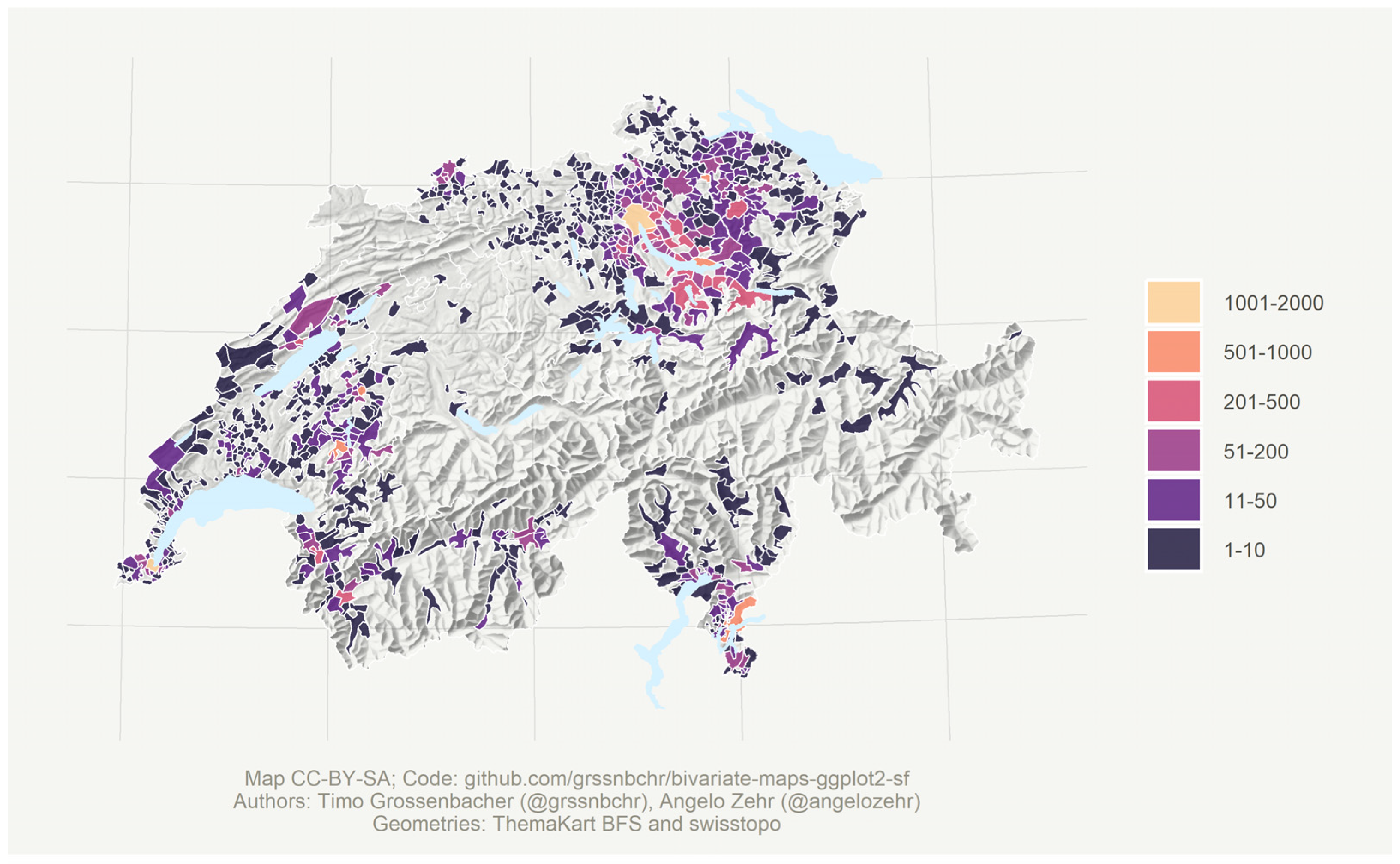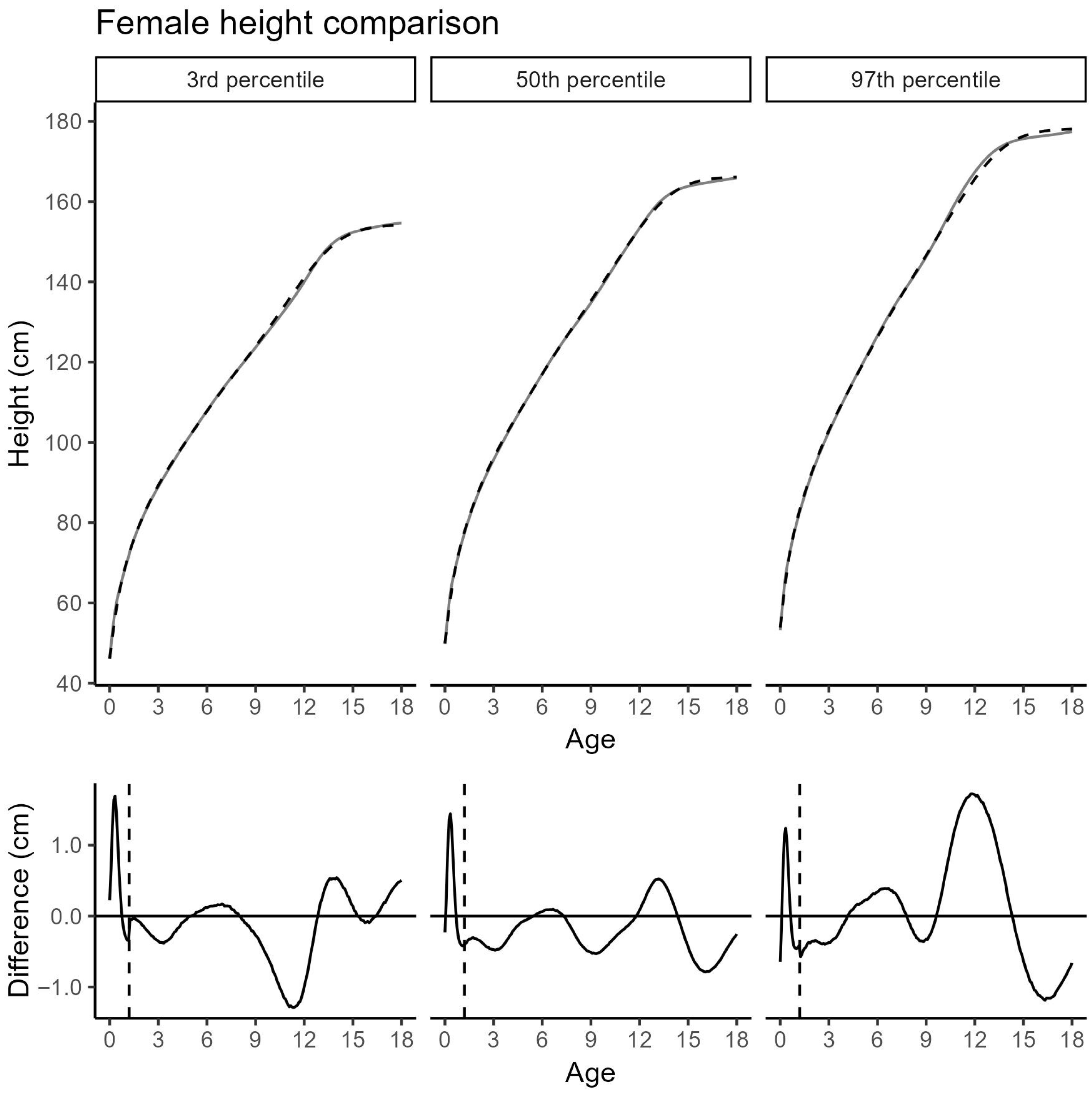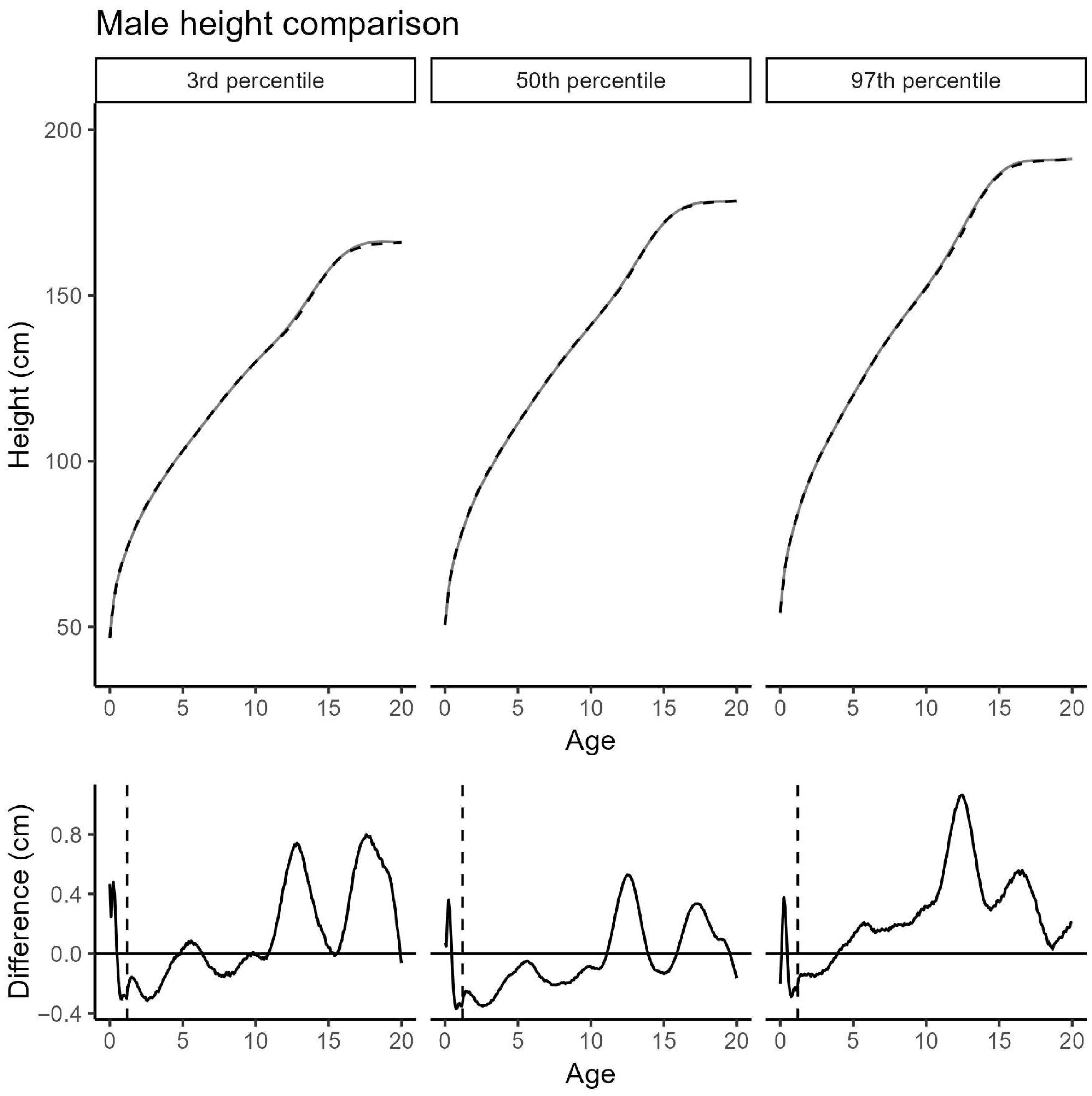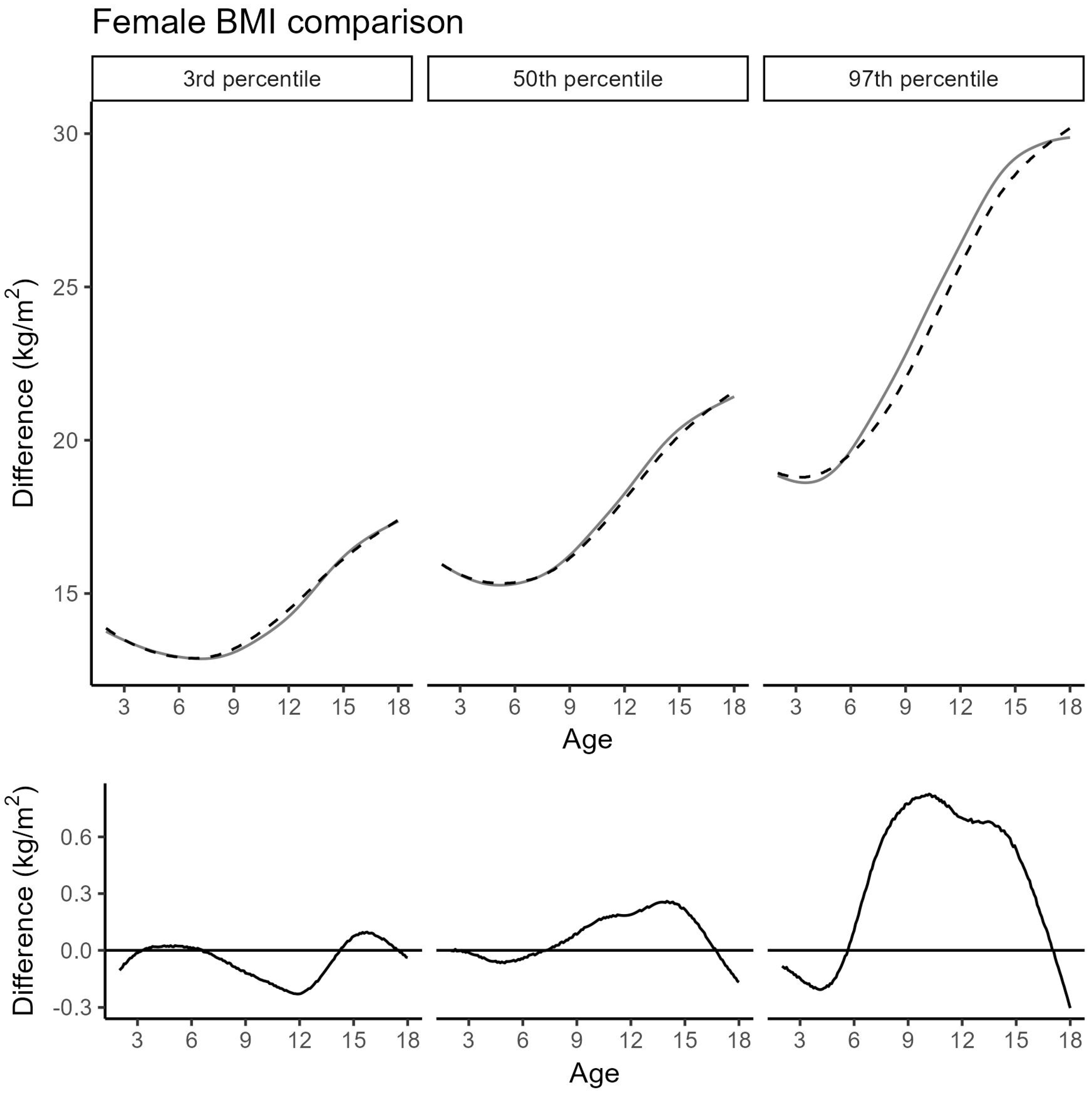Updated Swiss Growth References 2025: No Height Differences, but BMI Variations Associated with Migration
Abstract
1. Introduction
2. Materials and Methods
2.1. Study Design and Sample
2.2. Data Handling and Statistical Analysis
3. Results
3.1. Height
3.2. BMI
3.3. Cut-Off Values for Overweight and Obesity
3.4. Parental Origin Across Swiss Regions
3.5. Overweight and Obesity by Parental Origin
4. Discussion
4.1. Height
4.2. BMI
4.3. Disproportionate Burden of Overweight and Obesity by Country of Origin
4.4. Factors Influencing Growth Curve Updates and Limitations
5. Conclusions
Supplementary Materials
Author Contributions
Funding
Institutional Review Board Statement
Informed Consent Statement
Data Availability Statement
Acknowledgments
Conflicts of Interest
Abbreviations
| BEVNAT | German: Statistik der natürlichen Bevölkerungsbewegung |
| BMI | Body Mass Index |
| BCCGo | Box–Cox Cole and Green original distribution |
| CDC | Centers for Disease Control and Prevention |
| Cohort 2019 | Cohort studied in 2019 and published here: [14] |
| Cohort 2019 + 2025 | Extended current dataset, which includes additional proportional samples from the French- and Italian-speaking parts of Switzerland |
| GAMLSS | Generalized Additive Models for Location, Scale, and Shape |
| IOTF | International Obesity Task Force |
| LMS | Lambda–Mu–Sigma method for growth curve modelling |
| WHO | World Health Organization |
References
- Christesen, H.T.; Pedersen, B.T.; Pournara, E.; Petit, I.O.; Júlíusson, P.B. Short Stature: Comparison of WHO and National Growth Standards/References for Height. PLoS ONE 2016, 11, e0157277. [Google Scholar] [CrossRef] [PubMed] [PubMed Central]
- Cole, T.J. The secular trend in human physical growth: A biological view. Econ. Hum. Biol. 2003, 1, 161–168. [Google Scholar] [CrossRef] [PubMed]
- Wright, C.M.; Booth, I.W.; Buckler, J.M.; Cameron, N.; Cole, T.J.; Healy, M.J.; Hulse, J.A.; Preece, M.A.; Reilly, J.J.; Williams, A.F. Growth reference charts for use in the United Kingdom. Arch Dis. Child. 2002, 86, 11–14. [Google Scholar] [CrossRef] [PubMed] [PubMed Central]
- Bonthuis, M.; van Stralen, K.J.; Verrina, E.; Edefonti, A.; Molchanova, E.A.; Hokken-Koelega, A.C.; Schaefer, F.; Jager, K.J. Use of national and international growth charts for studying height in European children: Development of up-to-date European height-for-age charts. PLoS ONE 2012, 7, e42506. [Google Scholar] [CrossRef] [PubMed] [PubMed Central]
- Júlíusson, P.B.; Roelants, M.; Hoppenbrouwers, K.; Hauspie, R.; Bjerknes, R. Growth of Belgian and Norwegian children compared to the WHO growth standards: Prevalence below -2 and above +2 SD and the effect of breastfeeding. Arch. Dis. Child. 2011, 96, 916–921. [Google Scholar] [CrossRef] [PubMed]
- Gleiss, A.; Lassi, M.; Blümel, P.; Borkenstein, M.; Kapelari, K.; Mayer, M.; Schemper, M.; Häusler, G. Austrian height and body proportion references for children aged 4 to under 19 years. Ann. Hum. Biol. 2013, 40, 324–332. [Google Scholar] [CrossRef] [PubMed]
- Regecová, V.; Hamade, J.; Janechová, H.; Ševčíková, Ľ. Comparison of Slovak reference values for anthropometric parameters in children adolescents with international growth standards: Implications for the assessment of overweight obesity. Croat. Med. J. 2018, 59, 313–326. [Google Scholar] [CrossRef] [PubMed] [PubMed Central]
- Rosario, A.S.; Schienkiewitz, A.; Neuhauser, H. German height references for children aged 0 to under 18 years compared to WHO and CDC growth charts. Ann. Hum. Biol. 2011, 38, 121–130, Erratum in: Ann. Hum. Biol. 2014, 41, 381. [Google Scholar] [CrossRef] [PubMed]
- Saari, A.; Sankilampi, U.; Hannila, M.L.; Kiviniemi, V.; Kesseli, K.; Dunkel, L. New Finnish growth references for children and adolescents aged 0 to 20 years: Length/height-for-age, weight-for-length/height, and body mass index-for-age. Ann. Med. 2011, 43, 235–248. [Google Scholar] [CrossRef] [PubMed]
- Tanaka, H.; Ishii, H.; Yamada, T.; Akazawa, K.; Nagata, S.; Yamashiro, Y. Growth of Japanese breastfed infants compared to national references and World Health Organization growth standards. Acta Paediatr. 2013, 102, 739–743. [Google Scholar] [CrossRef] [PubMed]
- Cacciari, E.; Milani, S.; Balsamo, A.; Dammacco, F.; De Luca, F.; Chiarelli, F.; Pasquino, A.M.; Tonini, G.; Vanelli, M. Italian cross-sectional growth charts for height, weight and BMI (6-20 y). Eur. J. Clin. Nutr. 2002, 56, 171–180. [Google Scholar] [CrossRef] [PubMed]
- Ari Yuca, S.; Cesur, Y.; Kurtoğlu, S.; Mazıcıoğlu, M.M.; Cimbek, E.A. Growth patterns of children of same geographic background reared in different environments. J. Clin. Res. Pediatr. Endocrinol. 2014, 6, 233–237. [Google Scholar] [CrossRef] [PubMed] [PubMed Central]
- Federal Statistical Office (FSO). The Four Language Regions of Switzerland: Population by Main Language and Region; FSO: Neuchâtel, Switzerland, 2021; Swiss Stats Map Explorer; Available online: https://mapexplorer.bfs.admin.ch/#c=home (accessed on 3 July 2025).
- Eiholzer, U.; Fritz, C.; Katschnig, C.; Dinkelmann, R.; Stephan, A. Contemporary height, weight and body mass index references for children aged 0 to adulthood in Switzerland compared to the Prader reference, WHO and neighbouring countries. Ann. Hum. Biol. 2019, 46, 437–447, Erratum in Ann. Hum. Biol. 2020, 47, 504. [Google Scholar] [CrossRef] [PubMed]
- WHO/de Onis Multicentre Growth Reference Study Group. WHO Child Growth Standards based on length/height, weight and age. Acta Paediatr. Suppl. 2006, 450, 76–85. [Google Scholar] [CrossRef] [PubMed]
- de Onis, M.; Onyango, A.W.; Borghi, E.; Siyam, A.; Nishida, C.; Siekmann, J. Development of a WHO growth reference for school-aged children and adolescents. Bull. World Health Organ. 2007, 85, 660–667. [Google Scholar] [CrossRef] [PubMed] [PubMed Central]
- Prader, A.; Largo, R.H.; Molinari, L.; Issler, C. Physical growth of Swiss children from birth to 20 years of age. First Zurich longitudinal study of growth and development. Helv. Paediatr. Acta Suppl. 1989, 52, 1–125. [Google Scholar] [PubMed]
- Eiholzer, U.; Fritz, C.; Stephan, A. The increase in child obesity in Switzerland is mainly due to migration from Southern Europe—A cross-sectional study. BMC Public Health 2021, 21, 243. [Google Scholar] [CrossRef] [PubMed] [PubMed Central]
- Panczak, R.; Moser, A.; Held, L.; Jones, P.A.; Rühli, F.J.; Staub, K. A tall order: Small area mapping and modelling of adult height among Swiss male conscripts. Econ. Hum. Biol. 2017, 26, 61–69. [Google Scholar] [CrossRef] [PubMed]
- Larnkaer, A.; Attrup Schrøder, S.; Schmidt, I.M.; Hørby Jørgensen, M.; Fleischer Michaelsen, K. Secular change in adult stature has come to a halt in northern Europe and Italy. Acta Paediatr. 2006, 95, 754–755. [Google Scholar] [CrossRef] [PubMed]
- Cavelaars, A.E.; Kunst, A.E.; Geurts, J.J.; Crialesi, R.; Grötvedt, L.; Helmert, U.; Lahelma, E.; Lundberg, O.; Mielck, A.; Rasmussen, N.K.; et al. Persistent variations in average height between countries and between socio-economic groups: An overview of 10 European countries. Ann. Hum. Biol. 2000, 27, 407–421. [Google Scholar] [CrossRef] [PubMed]
- Danubio, M.E.; Sanna, E. Secular changes in human biological variables in Western countries: An updated review and synthesis. J. Anthropol. Sci. 2008, 86, 91–112. [Google Scholar] [PubMed]
- Ahrens, W.; Pigeot, I.; Pohlabeln, H.; De Henauw, S.; Lissner, L.; Molnár, D.; Moreno, L.A.; Tornaritis, M.; Veidebaum, T.; Siani, A. Prevalence of overweight and obesity in European children below the age of 10. Int. J. Obes. 2014, 38 (Suppl. 2), S99–S107. [Google Scholar] [CrossRef] [PubMed]
- Cadenas-Sanchez, C.; Nyström, C.; Sanchez-Delgado, G.; Martinez-Tellez, B.; Mora-Gonzalez, J.; Risinger, A.S.; Ruiz, J.R.; Ortega, F.B.; Löf, M. Prevalence of overweight/obesity and fitness level in preschool children from the north compared with the south of Europe: An exploration with two countries. Pediatr. Obes. 2016, 11, 403–410. [Google Scholar] [CrossRef] [PubMed]
- Parent, A.S.; Teilmann, G.; Juul, A.; Skakkebaek, N.E.; Toppari, J.; Bourguignon, J.P. The timing of normal puberty and the age limits of sexual precocity: Variations around the world, secular trends, and changes after migration. Endocr. Rev. 2003, 24, 668–693. [Google Scholar] [CrossRef] [PubMed]
- Ramnitz, M.S.; Lodish, M.B. Racial disparities in pubertal development. Semin. Reprod. Med. 2013, 31, 333–339. [Google Scholar] [CrossRef]
- Pinnaro, C.T.; Curtis, V.A. Variability in Pubertal Timing Among Asian American, Native Hawaiian, and Pacific Islander Subgroups. JAMA Netw. Open 2024, 7, e2410203. [Google Scholar] [CrossRef] [PubMed]
- Cole, T.J.; Green, P.J. Smoothing reference centile curves: The LMS method and penalized likelihood. Stat. Med. 1992, 11, 1305–1319. [Google Scholar] [CrossRef] [PubMed]
- Cole, T.J. Sample size and sample composition for constructing growth reference centiles. Stat. Methods Med. Res. 2021, 30, 488–507. [Google Scholar] [CrossRef] [PubMed] [PubMed Central]
- Cole, T.J.; Bellizzi, M.C.; Flegal, K.M.; Dietz, W.H. Establishing a standard definition for child overweight and obesity worldwide: International survey. BMJ 2000, 320, 1240–1243. [Google Scholar] [CrossRef] [PubMed] [PubMed Central]
- Wickham, H.; Averick, M.; Bryan, J.; Chang, W.; McGowan, L.D.; François, R.; Grolemund, G.; Hayes, A.; Henry, L.; Hester, J.; et al. Welcome to the tidyverse. J. Open Source Softw. 2019, 4, 1686. [Google Scholar] [CrossRef]
- Rigby, R.A.; Stasinopoulos, D.M. Generalized Additive Models for Location, Scale and Shape. J. R. Stat. Soc. Ser. C Appl. Stat. 2005, 54, 507–554. [Google Scholar] [CrossRef]
- Cole, T. _sitar: Super Imposition by Translation and Rotation Growth Curve, Analysis_. R package version 1.4.0. 2023. Available online: https://CRAN.R-project.org/package=sitar (accessed on 17 December 2024).
- Cole, T.J. Growth charts for both cross-sectional and longitudinal data. Stat. Med. 1994, 13, 2477–2492. [Google Scholar] [CrossRef] [PubMed]
- Rodríguez, G.; Moreno, L.A.; Sarría, A.; Fleta, J.; Bueno, M. Assessment of nutritional status and body composition in children using physical anthropometry and bioelectrical impedance: Influence of diurnal variations. J. Pediatr. Gastroenterol. Nutr. 2000, 30, 305–309. [Google Scholar] [CrossRef] [PubMed]
- Herter-Aeberli, I.; Osuna, E.; Sarnovská, Z.; Zimmermann, M.B. Significant Decrease in Childhood Obesity and Waist Circumference over 15 Years in Switzerland: A Repeated Cross-Sectional Study. Nutrients 2019, 11, 1922. [Google Scholar] [CrossRef] [PubMed] [PubMed Central]
- Hermanussen, M.; Stec, K.; Aßmann, C.; Meigen, C.; Van Buuren, S. Synthetic growth reference charts. Am. J. Hum. Biol. 2016, 28, 98–111. [Google Scholar] [CrossRef] [PubMed]
- Heude, B.; Scherdel, P.; Werner, A.; Le Guern, M.; Gelbert, N.; Walther, D.; Arnould, M.; Bellaïche, M.; Chevallier, B.; Cheymol, J.; et al. A big-data approach to producing descriptive anthropometric references: A feasibility and validation study of paediatric growth charts. Lancet Digit. Health 2019, 1, e413–e423. [Google Scholar] [CrossRef] [PubMed]






| Girls | Boys | |||||||
|---|---|---|---|---|---|---|---|---|
| Prospective | Prospective | |||||||
| Age Group (Years) | Pediatric Practice | Schools | Retrospective | Total | Pediatric Practice | Schools | Retrospective | Total |
| <2.00 | 3953 | 0 | 1475 a | 5428 | 3920 | 0 | 1511 a | 5431 |
| 2–3.99 | 1393 | 4 | 0 | 1397 | 1457 | 4 | 2 b | 1463 |
| 4–5.99 | 1274 | 2 | 1768 b | 3044 | 1475 | 3 | 1927 b | 3405 |
| 6–7.99 | 1046 | 198 | 405 b | 1649 | 1082 | 207 | 487 b | 1776 |
| 8–9.99 | 704 | 302 | 78 b | 1084 | 660 | 321 | 84 b | 1065 |
| 10–11.99 | 1096 | 93 | 1254 b | 2443 | 1126 | 106 | 1267 b | 2499 |
| 12–13.99 | 693 | 261 | 411 b | 1365 | 716 | 210 | 387 b | 1313 |
| 14–15.99 | 605 | 447 | 391 b | 1443 | 647 | 442 | 430 b | 1519 |
| 16–17.99 | 213 | 840 | 24 b | 1077 | 219 | 838 | 16 b | 1073 |
| 18–19.99 | 25 | 466 | 100 c | 591 | 32 | 627 | 2495 c | 3154 |
| 20–21.99 | 1 | 0 | 0 | 1 | 4 | 66 | 1000 c | 1070 |
| Total | 11,003 | 2613 | 5906 | 19,522 | 11,338 | 2824 | 9606 | 23,768 |
| Characteristic (For Data from Pediatric Practices and Schools) | Overall (Cohort 2019 + 2025) n = 43,290 1 | German-Speaking Switzerland n = 29,827 1 | Suisse Romande n = 10,889 1 | Ticino n = 2574 1 |
|---|---|---|---|---|
| Switzerland, both | 12,791 (42%) | 9305 (46%) | 2763 (34%) | 723 (30%) |
| Northern/Central Europe, both | 1698 (5.5%) | 1154 (5.7%) | 532 (6.5%) | 12 (0.5%) |
| Italy/Spain/Portugal, both | 2665 (8.7%) | 1147 (5.7%) | 968 (12%) | 550 (23%) |
| Balkan region, both | 2915 (9.5%) | 2048 (10%) | 645 (7.9%) | 222 (9.1%) |
| Turkey, both | 499 (1.6%) | 422 (2.1%) | 55 (0.7%) | 22 (0.9%) |
| other regions, both | 3095 (10%) | 1855 (9.2%) | 1055 (13%) | 185 (7.6%) |
| non-Swiss regions, mixed | 1726 (5.6%) | 848 (4.2%) | 666 (8.2%) | 212 (8.7%) |
| Switzerland, one | 5375 (17%) | 3389 (17%) | 1483 (18%) | 503 (21%) |
| Unknown (for retrospective data: newborns, military recruits, and school medical service) | 12,526 | 9659 | 2722 | 145 |
| Girls | Boys | |||||||||||||
|---|---|---|---|---|---|---|---|---|---|---|---|---|---|---|
| Age (Years) | 3rd | 10th | 25th | 50th | 75th | 90th | 97th | 3rd | 10th | 25th | 50th | 75th | 90th | 97th |
| 0 | 46.3 | 47.4 | 48.5 | 49.7 | 51.0 | 52.1 | 53.2 | 47.0 | 48.1 | 49.3 | 50.5 | 51.8 | 53.0 | 54.2 |
| 0.25 | 55.6 | 57.0 | 58.3 | 59.8 | 61.3 | 62.6 | 64.0 | 57.1 | 58.4 | 59.8 | 61.2 | 62.7 | 64.1 | 65.5 |
| 0.5 | 61.6 | 63.1 | 64.6 | 66.2 | 67.9 | 69.4 | 70.9 | 63.6 | 65.0 | 66.3 | 67.9 | 69.5 | 70.9 | 72.3 |
| 0.75 | 65.7 | 67.2 | 68.8 | 70.5 | 72.3 | 73.9 | 75.5 | 67.7 | 69.1 | 70.6 | 72.3 | 74.0 | 75.5 | 77.0 |
| 1 | 69.3 | 71.0 | 72.6 | 74.5 | 76.3 | 78.0 | 79.7 | 71.1 | 72.7 | 74.3 | 76.0 | 77.8 | 79.5 | 81.1 |
| 1.25 | 72.9 | 74.5 | 76.2 | 78.0 | 79.9 | 81.6 | 83.3 | 74.3 | 75.9 | 77.6 | 79.5 | 81.4 | 83.1 | 84.9 |
| 1.5 | 75.9 | 77.6 | 79.3 | 81.2 | 83.2 | 85.0 | 86.7 | 77.2 | 78.9 | 80.6 | 82.6 | 84.7 | 86.5 | 88.3 |
| 1.75 | 78.6 | 80.3 | 82.1 | 84.1 | 86.2 | 88.0 | 89.9 | 79.8 | 81.6 | 83.4 | 85.5 | 87.6 | 89.5 | 91.5 |
| 2 | 81.0 | 82.8 | 84.7 | 86.8 | 88.9 | 90.8 | 92.8 | 82.2 | 84.0 | 86.0 | 88.1 | 90.3 | 92.3 | 94.3 |
| 3 | 89.0 | 91.1 | 93.2 | 95.7 | 98.1 | 100.4 | 102.6 | 90.1 | 92.3 | 94.4 | 96.9 | 99.4 | 101.7 | 103.9 |
| 4 | 95.7 | 98.1 | 100.6 | 103.3 | 106.1 | 108.6 | 111.2 | 97.0 | 99.3 | 101.7 | 104.4 | 107.2 | 109.7 | 112.2 |
| 5 | 102.0 | 104.6 | 107.3 | 110.3 | 113.4 | 116.2 | 119.0 | 103.1 | 105.7 | 108.4 | 111.4 | 114.5 | 117.2 | 120.0 |
| 6 | 107.9 | 110.8 | 113.7 | 117.1 | 120.5 | 123.5 | 126.6 | 108.8 | 111.7 | 114.7 | 118.0 | 121.4 | 124.5 | 127.5 |
| 7 | 113.5 | 116.6 | 119.8 | 123.4 | 127.1 | 130.4 | 133.7 | 114.5 | 117.5 | 120.7 | 124.3 | 127.9 | 131.2 | 134.5 |
| 8 | 118.6 | 121.9 | 125.3 | 129.1 | 132.9 | 136.4 | 139.9 | 120.0 | 123.2 | 126.5 | 130.2 | 133.9 | 137.4 | 140.8 |
| 9 | 123.7 | 127.2 | 130.7 | 134.8 | 138.8 | 142.6 | 146.3 | 125.2 | 128.5 | 131.9 | 135.7 | 139.6 | 143.2 | 146.7 |
| 10 | 128.8 | 132.6 | 136.6 | 141.0 | 145.5 | 149.5 | 153.6 | 130.0 | 133.4 | 137.0 | 141.0 | 145.1 | 148.9 | 152.6 |
| 11 | 134.1 | 138.3 | 142.5 | 147.3 | 152.2 | 156.7 | 161.1 | 134.5 | 138.2 | 142.1 | 146.5 | 150.9 | 154.9 | 159.0 |
| 12 | 140.0 | 144.2 | 148.5 | 153.4 | 158.3 | 162.8 | 167.3 | 139.3 | 143.4 | 147.7 | 152.5 | 157.4 | 161.9 | 166.3 |
| 13 | 146.3 | 150.2 | 154.3 | 158.9 | 163.5 | 167.7 | 171.9 | 145.1 | 149.6 | 154.2 | 159.4 | 164.6 | 169.5 | 174.3 |
| 14 | 150.4 | 154.1 | 157.9 | 162.2 | 166.6 | 170.5 | 174.5 | 151.6 | 156.2 | 160.9 | 166.2 | 171.6 | 176.5 | 181.5 |
| 15 | 152.4 | 156.0 | 159.7 | 163.8 | 168.0 | 171.9 | 175.7 | 157.6 | 162.1 | 166.7 | 171.8 | 177.1 | 181.9 | 186.7 |
| 16 | 153.3 | 156.9 | 160.5 | 164.6 | 168.8 | 172.5 | 176.3 | 162.2 | 166.4 | 170.8 | 175.6 | 180.6 | 185.1 | 189.6 |
| 17 | 154.1 | 157.7 | 161.3 | 165.3 | 169.4 | 173.1 | 176.8 | 165.0 | 168.9 | 173.0 | 177.6 | 182.2 | 186.4 | 190.7 |
| 18 | 154.7 | 158.2 | 161.8 | 165.9 | 170.0 | 173.7 | 177.4 | 166.1 | 169.9 | 173.8 | 178.3 | 182.7 | 186.8 | 190.9 |
| 19 | 166.3 | 170.1 | 174.0 | 178.4 | 182.8 | 186.9 | 190.9 | |||||||
| 20 | 166.0 | 169.9 | 173.9 | 178.4 | 182.9 | 187.1 | 191.3 | |||||||
| Girls Aged 8 to 15 Years | |||
|---|---|---|---|
| Region | All Percentiles | 97th–100th | Residual in 97th–100th |
| German-speaking Switzerland | 2346 (64%) | 50 (49%) | −3.0 * |
| Suisse Romande | 971 (26%) | 38 (38%) | 2.5 * |
| Ticino | 373 (10%) | 14 (14%) | 1.2 |
| Chi-square statistic | 9.0664; p = 0.011 | ||
| Girls | Boys | |||||||||||||
|---|---|---|---|---|---|---|---|---|---|---|---|---|---|---|
| Age (Years) | 3rd | 10th | 25th | 50th | 75th | 90th | 97th | 3rd | 10th | 25th | 50th | 75th | 90th | 97th |
| 2 | 13.8 | 14.4 | 15.1 | 16.0 | 16.9 | 17.8 | 18.9 | 14.0 | 14.6 | 15.3 | 16.1 | 17.1 | 18.2 | 19.4 |
| 3 | 13.5 | 14.1 | 14.8 | 15.6 | 16.6 | 17.6 | 18.7 | 13.7 | 14.2 | 14.9 | 15.7 | 16.7 | 17.7 | 18.9 |
| 4 | 13.2 | 13.8 | 14.5 | 15.4 | 16.4 | 17.4 | 18.7 | 13.4 | 14.0 | 14.7 | 15.5 | 16.5 | 17.5 | 18.8 |
| 5 | 13.1 | 13.7 | 14.4 | 15.3 | 16.4 | 17.5 | 19.0 | 13.3 | 13.9 | 14.6 | 15.5 | 16.5 | 17.6 | 19.0 |
| 6 | 12.9 | 13.6 | 14.3 | 15.3 | 16.5 | 17.9 | 19.7 | 13.1 | 13.8 | 14.5 | 15.5 | 16.7 | 17.9 | 19.4 |
| 7 | 12.9 | 13.6 | 14.4 | 15.5 | 16.9 | 18.5 | 20.6 | 13.0 | 13.7 | 14.5 | 15.6 | 16.9 | 18.3 | 20.1 |
| 8 | 12.9 | 13.7 | 14.6 | 15.8 | 17.3 | 19.2 | 21.7 | 13.0 | 13.8 | 14.7 | 15.8 | 17.3 | 18.9 | 21.0 |
| 9 | 13.1 | 13.9 | 14.9 | 16.2 | 18.0 | 20.0 | 22.8 | 13.2 | 14.0 | 15.0 | 16.3 | 17.9 | 19.8 | 22.2 |
| 10 | 13.4 | 14.3 | 15.4 | 16.9 | 18.8 | 21.0 | 24.0 | 13.5 | 14.4 | 15.4 | 16.8 | 18.6 | 20.7 | 23.6 |
| 11 | 13.8 | 14.8 | 15.9 | 17.5 | 19.6 | 22.0 | 25.2 | 13.9 | 14.8 | 15.9 | 17.4 | 19.4 | 21.7 | 24.9 |
| 12 | 14.3 | 15.3 | 16.6 | 18.3 | 20.4 | 23.0 | 26.4 | 14.3 | 15.2 | 16.4 | 18.0 | 20.1 | 22.6 | 26.1 |
| 13 | 14.9 | 16.0 | 17.3 | 19.0 | 21.3 | 24.0 | 27.5 | 14.7 | 15.7 | 16.9 | 18.6 | 20.8 | 23.5 | 27.2 |
| 14 | 15.6 | 16.7 | 18.0 | 19.8 | 22.1 | 24.8 | 28.5 | 15.2 | 16.3 | 17.5 | 19.3 | 21.6 | 24.3 | 28.2 |
| 15 | 16.2 | 17.3 | 18.6 | 20.4 | 22.7 | 25.4 | 29.2 | 15.8 | 16.9 | 18.2 | 20.0 | 22.3 | 25.2 | 29.1 |
| 16 | 16.7 | 17.8 | 19.0 | 20.8 | 23.1 | 25.8 | 29.6 | 16.5 | 17.6 | 18.9 | 20.7 | 23.1 | 26.0 | 29.9 |
| 17 | 17.1 | 18.1 | 19.4 | 21.1 | 23.4 | 26.1 | 29.8 | 17.0 | 18.2 | 19.5 | 21.4 | 23.8 | 26.7 | 30.7 |
| 18 | 17.4 | 18.4 | 19.7 | 21.4 | 23.7 | 26.3 | 29.9 | 17.5 | 18.7 | 20.1 | 22.0 | 24.4 | 27.3 | 31.3 |
| 19 | 17.9 | 19.1 | 20.5 | 22.4 | 24.9 | 27.9 | 32.0 | |||||||
| 20 | 18.2 | 19.4 | 20.9 | 22.8 | 25.4 | 28.4 | 32.6 | |||||||
| Cohort 2019 + 2025 | ||||||
|---|---|---|---|---|---|---|
| Girls | Boys | |||||
| n | Overweight | Obese | n | Overweight | Obese | |
| Switzerland, both | 4009 | 9.8 | 1.9 | 4108 | 10.2 | 1.6 |
| Northern/Central Europe, both | 576 | 7.5 | 1.2 | 567 | 7.2 | 1.2 |
| Italy/Spain/Portugal, both | 835 | 20.1 | 6.1 | 933 | 19.1 | 4.4 |
| Balkan region, both | 826 | 20.2 | 6.4 | 1055 | 27.2 | 8.5 |
| Turkey, both | 165 | 21.8 | 4.2 | 176 | 25.6 | 6.2 |
| Switzerland, one | 1696 | 11.1 | 1.7 | 1770 | 10.6 | 2.1 |
| Other regions/Parents not from the same region | 1555 | 17.4 | 3.0 | 1629 | 16.9 | 3.7 |
| Total | 9662 | 13.1 | 2.8 | 10,238 | 14.0 | 3.0 |
Disclaimer/Publisher’s Note: The statements, opinions and data contained in all publications are solely those of the individual author(s) and contributor(s) and not of MDPI and/or the editor(s). MDPI and/or the editor(s) disclaim responsibility for any injury to people or property resulting from any ideas, methods, instructions or products referred to in the content. |
© 2025 by the authors. Licensee MDPI, Basel, Switzerland. This article is an open access article distributed under the terms and conditions of the Creative Commons Attribution (CC BY) license (https://creativecommons.org/licenses/by/4.0/).
Share and Cite
Eiholzer, U.; Stephan, A.; Dubinski, I.; Fritz, C.; Noordam, C. Updated Swiss Growth References 2025: No Height Differences, but BMI Variations Associated with Migration. J. Clin. Med. 2025, 14, 5912. https://doi.org/10.3390/jcm14165912
Eiholzer U, Stephan A, Dubinski I, Fritz C, Noordam C. Updated Swiss Growth References 2025: No Height Differences, but BMI Variations Associated with Migration. Journal of Clinical Medicine. 2025; 14(16):5912. https://doi.org/10.3390/jcm14165912
Chicago/Turabian StyleEiholzer, Urs, Anika Stephan, Ilja Dubinski, Christiane Fritz, and Cees Noordam. 2025. "Updated Swiss Growth References 2025: No Height Differences, but BMI Variations Associated with Migration" Journal of Clinical Medicine 14, no. 16: 5912. https://doi.org/10.3390/jcm14165912
APA StyleEiholzer, U., Stephan, A., Dubinski, I., Fritz, C., & Noordam, C. (2025). Updated Swiss Growth References 2025: No Height Differences, but BMI Variations Associated with Migration. Journal of Clinical Medicine, 14(16), 5912. https://doi.org/10.3390/jcm14165912







